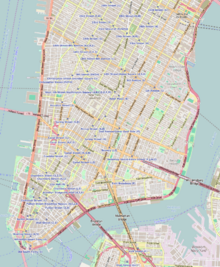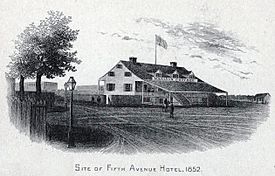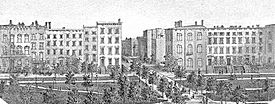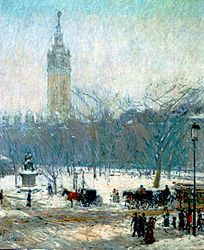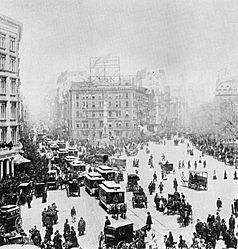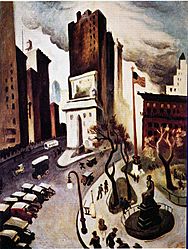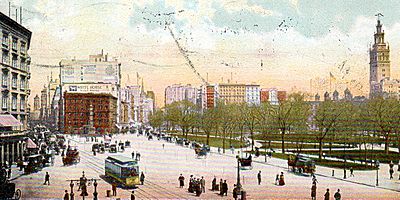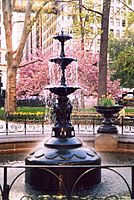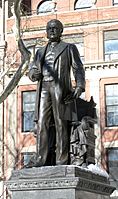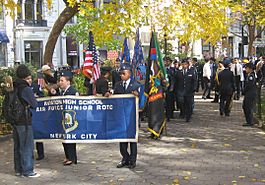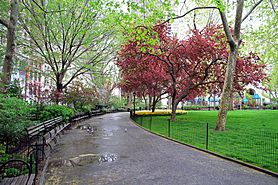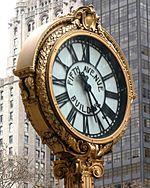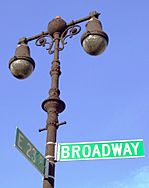Madison Square and Madison Square Park facts for kids

Snow-covered Madison Square Park at night, looking south (December 2005)
|
|
| Namesake | James Madison |
|---|---|
| Maintained by | City of New York |
| Location | New York City, New York, U.S. |
| Coordinates | 40°44′31″N 73°59′17″W / 40.742054°N 73.987984°W |
| North | 26th Street |
| East | Madison Avenue |
| South | 23rd Street |
| West | Fifth Avenue and Broadway |
| Other | |
| Website | Madison Square Park |
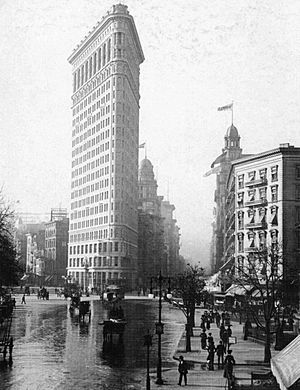
Madison Square is a famous public square in New York City. It's located in the Manhattan area, where Fifth Avenue and Broadway meet at 23rd Street. The square is named after James Madison, who was one of the Founding Fathers and the fourth President of the United States.
The main part of Madison Square is Madison Square Park. This park is about 6.2 acres (2.5 hectares) big. It's bordered by Madison Avenue to the east, 23rd Street to the south, 26th Street to the north, and Fifth Avenue and Broadway to the west.
The park and square are at the northern end of the Flatiron District neighborhood. To the north and west is an area called NoMad, which means "NOrth of MADison Square Park." To the north and east is Rose Hill.
Madison Square is well-known because it gave its name to the famous sports arena, Madison Square Garden. The first two arenas were located near the park for 47 years, until 1925. The current Madison Square Garden building is not in this area anymore.
Many famous buildings are around Madison Square. These include the Flatiron Building, the New York Life Building, the Appellate Division Courthouse, and the Met Life Tower.
Contents
How Madison Square Began
The area where Madison Square is today used to be a swampy hunting ground. A creek, later called Madison Creek, ran through it. It became a public space in 1686. In the 1700s, it was used as a burial ground.
In 1807, a large area called "The Parade" was set aside. It stretched from 23rd to 34th Street and from Third to Seventh Avenue. This land was meant for a military arsenal, barracks, and training area. A United States Army arsenal was there from 1811 to 1825. After that, it became a home for young people under 16 who were sent there by the courts. In 1839, the building burned down. The size of "The Parade" was made smaller in 1814, and it got its current name, Madison Square.
In 1839, a farmhouse at Fifth Avenue and 23rd Street became a place for travelers to stop. It was called "Madison Cottage" after President Madison. This was the last stop for people leaving the city to the north, or the first stop for those arriving. Madison Cottage was torn down in 1852. However, it gave its name to Madison Avenue and the park. So, the park and avenue are named after the cottage, which was named after President Madison.
The New York Knickerbocker Base Ball Club, one of the first organized baseball teams, started near Madison Square. In 1842, amateur players used a sandy lot at 27th and Madison for their games. Later, they moved to Hoboken, New Jersey, and played their first official game in 1846.
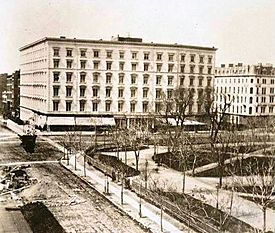
When the Park Opened
On May 10, 1847, the 6.2-acre Madison Square Park officially opened to the public. In a few years, more and more homes were built around the park. At first, these were narrow brownstone houses. Today, only one of these old brownstones remains at 14 East 23rd Street.
By the 1870s, the area became a very fancy neighborhood. Wealthy families lived in large brownstone homes and mansions. Famous people like Theodore Roosevelt and Edith Wharton were born here.
In 1852, Franconi's Hippodrome was built where Madison Cottage used to be. It was a huge arena that could seat 10,000 people. It hosted chariot races and showed exotic animals. It closed after only two years. The Fifth Avenue Hotel was later built on this site.
In 1853, there were plans to build the Crystal Palace in the park. But people protested, and the palace was built elsewhere.
During the 1863 New York City draft riots, 10,000 soldiers camped in Madison Square. They were there to help control the riots. Madison Square was also a place for big political rallies. In 1864, a large rally for presidential candidate George B. McClellan was held there.
Businesses Move In
The Fifth Avenue Hotel was a luxury hotel built on the west side of Madison Square. It was open from 1859 to 1908. It was the first hotel in the country to have elevators, which were powered by steam. These elevators made the upper floors more popular. The hotel had fireplaces in every room and private bathrooms. Many important events took place there.
Many famous people stayed at the hotel, including Mark Twain and several U.S. Presidents like Abraham Lincoln and Ulysses S. Grant. Theodore Roosevelt even had his campaign offices there. The hotel was torn down in 1908. A plaque on the Toy Center, which is now on the site, remembers the hotel.
After the Fifth Avenue Hotel became popular, other grand hotels opened nearby. Entertainment places like the Madison Square Theatre also appeared. Fancy restaurants like Delmonico's and high-end shops opened along Fifth Avenue and Broadway. Exclusive private clubs also moved into the area. However, some "concert-saloons" also opened, offering music and drinks.
As the city grew northward, the Madison Square area became more commercial. Wealthy residents moved further uptown. This allowed more restaurants, theaters, and clubs to open. It became a lively entertainment district. Large department stores also brought many shoppers during the day. Madison Square was no longer mainly residential, but it was still a busy and important area.
Worth Square
At the western side of Madison Square Park is Worth Square. It has a tall stone monument, called an obelisk. This monument was built in 1857 over the tomb of General William Jenkins Worth. He was a hero in the Seminole Wars and the Mexican War. Fort Worth, Texas, is named after him. The area around the monument is a small park.
Park Improvements
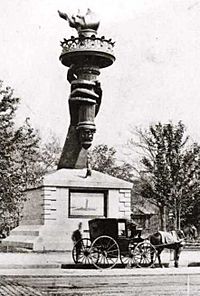
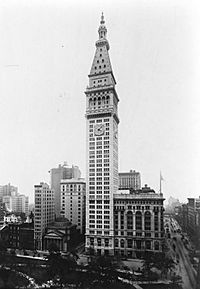
Madison Square Park became a bit smaller in 1870. The west side was reduced to make Broadway wider. But the park was also redesigned by William Grant and Ignatz Pilat. The park's current look still follows their design.
New Features in the Park
The new design brought sculptures to the park. One important statue is of William H. Seward, a Secretary of State who bought Alaska from Russia. This bronze statue was made by Randolph Rogers in 1876.
Other statues in the park include:
- Roscoe Conkling, a politician who collapsed in the park during a big snowstorm in 1888.
- Chester Alan Arthur, the 21st President of the United States.
- David Farragut, a Civil War admiral famous for saying, "Damn the torpedoes, full speed ahead!" His memorial was designed by Augustus Saint-Gaudens and Stanford White.
Along the south side of the park is the Eternal Light Flagstaff. It was put there in 1923 to remember American soldiers who returned from World War I. It was fixed up in 2002.
Another park highlight is the granite Southern Fountain. This is a modern copy of the original fountain, which was first built in 1843. The new one was put in the park in 1990 and updated in 2015.
Jemmy's Dog Run, a place for dogs to play, is also in the park near West 25th Street. It was made bigger in 2022.
New Ideas and Style
Madison Square continued to be a center for public activities. In the 1870s, a building facing Madison Square was used for advertisements. The New York Times put up a sign with electric lights. Later, images were projected onto a screen on the wall. Both the Times and the New York Tribune used this screen for news updates. On election nights, thousands of people gathered in Madison Square to wait for the latest results.
In 1876, a big celebration was held in the park for the 100th birthday of the Declaration of Independence. From 1876 to 1882, the torch and arm of the Statue of Liberty were shown in the park. This was to help raise money to build the statue's base.
Madison Square was one of the first places in the city to have electric street lights. In 1879, electric lights were installed on Broadway between Union Square and Madison Square. They were turned on in December 1880. A year later, tall "sun towers" with bright lights were put in Union and Madison Squares.
The area around Madison Square remained a fashionable place for businesses. In 1883, the American Art Association opened nearby. It was the first auction house in the U.S. where people could buy and sell art, jewelry, and rare books.
Madison Square Garden's History
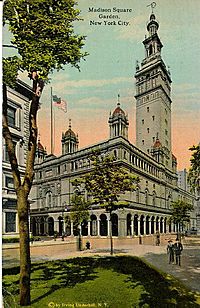
The first building that became Madison Square Garden was built in 1832. It was a train station for the New York and Harlem Rail Road. After the train station moved, the building was empty until 1873. Then, P.T. Barnum used it for circus shows, animal exhibits, and other performances.
In 1875, a band leader named Patrick Sarsfield Gilmore rented the space. He filled it with trees, flowers, and fountains and called it "Gilmore's Concert Garden." His band played many concerts there. After he left, others used it for races, meetings, and dog shows. Boxing "exhibitions" were also held there, as real boxing matches were illegal.
The building was finally named "Madison Square Garden" in 1879 by William Kissam Vanderbilt. He continued to host sports events, horse shows, and boxing matches. He later sold the building to a group of wealthy people.
A new, beautiful building designed by architect Stanford White replaced the first Garden. Stanford White had an apartment in the building. He was shot and killed in the Garden's rooftop restaurant. This event caused a huge scandal and was widely reported in the news.
The second Madison Square Garden had a large bronze statue of the Roman goddess Diana on top of its 32-story tower. This made the building very famous.
The Garden hosted many events, including circuses, concerts, operas, and even the 1924 Democratic National Convention. However, it never made much money. It was torn down soon after, and the venue moved uptown. Today, the arena still has the name "Madison Square Garden," even though it is no longer in the Madison Square area.
Ceremonial Arches
To celebrate George Washington's first time as president in 1889, two temporary arches were built over Fifth Avenue. Ten years later, in 1899, the Dewey Arch was built over Fifth Avenue at Madison Square. This was for a parade honoring Admiral George Dewey, who won a big naval battle. The arch was meant to be temporary and was taken down in 1901.
In 1918, another arch, called the Victory Arch, was built in the same area. It honored the city's soldiers who died in World War I. This arch was also temporary.
Madison Square in the 1900s
Early 1900s
In 1901, there was an unusual public protest in the park. A man was allowed to put 200 rocking chairs in Madison Square Park and charge people 5 cents to sit in them. Free benches were moved away from the shade. When a heat wave hit, people refused to pay to sit in the shade. Police got involved, and newspapers wrote about it. People started going to the park to sit without paying. A small riot happened, with people overturning chairs. The city eventually canceled the contract for the pay chairs.
Two months later, in September 1901, a band played "Nearer, My God, to Thee" in the park. This was to honor President William McKinley after he was assassinated. It was his favorite song.
On election night in November 1902, a fireworks display went wrong. It caused the deaths of 15 people and injured 70. The fireworks were meant to celebrate an election win.
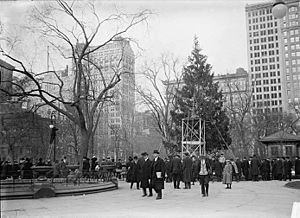
In 1908, a newspaper put a giant searchlight on the Met Life Tower. It signaled election results. A beam pointing north meant a Republican win, and south meant a Democrat win. The beam went north, showing William Howard Taft won.
America's first public Christmas tree was lit in Madison Square Park on December 24, 1912. A special "Star of Hope" light, put up in 1916, now remembers this event. Today, the Madison Square Park Conservancy still holds an annual tree-lighting ceremony.
The author Willa Cather described Madison Square around 1915. She said it had a "double personality," with shops to the south and homes to the north. She thought it felt like an "open-air drawing-room."
A Business Area
In the early 1900s, the area around Madison Square became known for clothing manufacturers. Toy companies also moved in during World War I. The Lionel Train Company had its headquarters there. Its competitor, the A. C. Gilbert Company, also had a "Hall of Science" nearby.
Many toy manufacturers had offices at 200 Fifth Avenue, where the Fifth Avenue Hotel used to be. This building became the International Toy Center. It was the site of the annual New York Toy Fair for many years. Major toy companies like Mattel and Hasbro later moved to their own nearby headquarters.
Mid-Century Changes
In 1936, an oak tree from James Madison's estate in Virginia was planted in Madison Square Park. This was to celebrate the 100th anniversary of Madison Avenue.
In 1964, there was a plan to build a parking garage under the park. But people who wanted to protect the park stopped the plan. They were worried about damage to the park's trees.
On October 17, 1966, a fire at 7 East 23rd Street caused a building to collapse. Twelve firefighters died. This was the biggest loss of life for the department before the September 11 attacks. A plaque on the building now there remembers the victims.
Park Restoration
By the mid-1900s, the park and nearby buildings needed a lot of work. In 1979, a private group started a program to clean and maintain the park. This was the first time private money was used for long-term park work in New York City.
In 1986, a full restoration of the park began. The first part, including the north end and Worth Square, was finished in 1988. A playground was added in the northeast corner. The rest of the park was restored later.
In 1997, the New York City Department of Parks and Recreation asked for help to finish the park's revitalization. This led to the creation of the Madison Square Park Conservancy. This group works to keep the park "a bright, beautiful and active public park."

In July 2004, the Shake Shack opened in the park. It's a very popular stand that sells hamburgers, hot dogs, shakes, and other food. Its unique building is near the park's southeast entrance. In 2010, the park's planting beds were redesigned.
Madison Square Today
The names of the neighborhoods around Madison Square often change. Around the park and to the south is the Flatiron District. This area used to be mainly for businesses, but now many people live there. Rose Hill is to the north and east of the park. NoMad is to the north, and Chelsea is to the west.
Madison Avenue is still mostly a business area. Broadway, just north of the square, has many small shops. The area west of the square is still commercial, but many new homes are being built.
In 1989, the city created the Ladies' Mile Historic District to protect the area. Also, since 2001, the Madison Square North Historic District protects the area north and west of the park, known as NoMad.
Important Buildings Today

At the south end of Madison Square is the Flatiron Building. It's one of New York's oldest skyscrapers, built in 1902. Just to its east is the Met Life Tower at 1 Madison Avenue. Built in 1909, it was the tallest building in the world until 1913. Today, its clock tower has a luxury hotel, and the office space is being updated. This 700-foot (213-meter) marble clock tower is a major landmark.
Nearby, on Madison Avenue, is the New York Life Building. It's 40 floors high and was built in 1928. It has a square tower with a shiny gold pyramid on top. Also, the Appellate Division Courthouse on Madison Avenue has interesting statues.
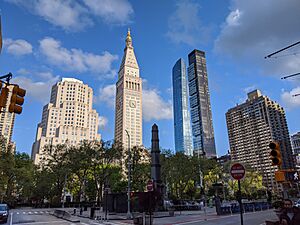
To the west of the Flatiron Building is the Western Union Telegraph Building. It was built in 1884 and was one of the first business buildings in the area.
Tall Homes
One Madison is a 50-story apartment building that opened in 2013. It's located across from the park at 22 East 23rd Street. Down the block, at 5 East 22nd Street, is the Madison Green apartment tower. This 31-story building was built in 1982 and was one of the first signs that the area was becoming popular again.
Near the other end of 22nd Street is the Madison Square Park Tower. This 64-story apartment building was finished in 2017.
Getting Around
You can reach Madison Square by the New York City Subway. The local trains on the BMT Broadway Line stop at the 23rd Street station. There are also local subway stops one block away on the IRT Lexington Avenue Line and IND Sixth Avenue Line.
Images for kids
- In the past
-
Snowstorm, Madison Square
by Childe Hassam (around 1890).
Stanford White's Madison Square Garden
is in the background. -
In 1920, the American artist Thomas Hart Benton showed the Seward statue, the Eternal Light flagpole, and the Worth monument in his painting New York, Early Twenties.
-
The Square and Park in 1908;
the Flatiron Building
is on the right
- The park today
-
William H. Seward,
the Secretary of State who bought Alaska -
The fountain,
a modern copy installed in 1990 based on the 1867 original, restored in 2015 -
Roscoe Conkling
was a Republican political leader -
President Chester A. Arthur
-
The annual New York City Veterans Day Parade starts in the park and marches up Madison Avenue
See also
 In Spanish: Madison Square para niños
In Spanish: Madison Square para niños
- Flatiron Building
- Flatiron District
- Madison Square North Historic District
- Madison Square Park Fountain
- Met Life Tower
- NoMad
- Park conservancy
- Rose Hill, Manhattan


